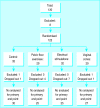Single blind, randomised controlled trial of pelvic floor exercises, electrical stimulation, vaginal cones, and no treatment in management of genuine stress incontinence in women
- PMID: 10024253
- PMCID: PMC27740
- DOI: 10.1136/bmj.318.7182.487
Single blind, randomised controlled trial of pelvic floor exercises, electrical stimulation, vaginal cones, and no treatment in management of genuine stress incontinence in women
Abstract
Objective: To compare the effect of pelvic floor exercises, electrical stimulation, vaginal cones, and no treatment for genuine stress incontinence.
Design: Stratified, single blind, randomised controlled trial.
Setting: Multicentre.
Participants: 107 women with clinically and urodynamically proved genuine stress incontinence. Mean (range) age was 49.5 (24-70) years, and mean (range) duration of symptoms 10.8 (1-45) years.
Interventions: Pelvic floor exercise (n=25) comprised 8-12 contractions 3 times a day and exercise in groups with skilled physical therapists once a week. The electrical stimulation group (n=25) used vaginal intermittent stimulation with the MS 106 Twin at 50 Hz 30 minutes a day. The vaginal cones group (n=27) used cones for 20 minutes a day. The untreated control group (n=30) was offered the use of a continence guard. Muscle strength was measured by vaginal squeeze pressure once a month.
Main outcome measures: Pad test with standardised bladder volume, and self report of severity.
Results: Improvement in muscle strength was significantly greater (P=0.03) after pelvic floor exercises (11.0 cm H2O (95% confidence interval 7.7 to 14.3) before v 19.2 cm H2O (15.3 to 23.1) after) than either electrical stimulation (14.8 cm H2O (10. 9 to 18.7) v 18.6 cm H2O (13.3 to 23.9)) or vaginal cones (11.8 cm H2O (8.5 to 15.1) v 15.4 cm H2O (11.1 to 19.7)). Reduction in leakage on pad test was greater in the exercise group (-30.2 g; -43. 3 to 16.9) than in the electrical stimulation group (-7.4 g; -20.9 to 6.1) and the vaginal cones group (-14.7 g; -27.6 to -1.8). On completion of the trial one participant in the control group, 14 in the pelvic floor exercise group, three in the electrical stimulation group, and two in the vaginal cones group no longer considered themselves as having a problem.
Conclusion: Training of the pelvic floor muscles is superior to electrical stimulation and vaginal cones in the treatment of genuine stress incontinence.
Figures
References
-
- Abrams P, Blaivas JG, Stanton SL, Andersen JT. The standardisation of terminology of the lower urinary tract function. Scand J Urol Nephrol Suppl. 1988;114:5–19. - PubMed
-
- Fantl J, Newman D, Colling J, DeLancy JOL, Keeys C, Loughery R, et al. Urinary incontinence in adults: acute and chronic management. 2nd update. Rockville, Maryland: Department of Health and Human Services, Public Health Service, Agency for Health Care Policy and Research; 1996. (Clinical Practice Guideline, 96-0682.)
-
- Hunskaar S, Vinsnes A. The quality of life in women with urinary incontinence as measured by the sickness impact profile. J Am Geriatr Soc. 1991;39:378–382. - PubMed
-
- Bø K, Hagen R, Kvarstein B, Larsen S. Female stress urinary incontinence and participation in different sport and social activities. Scand J Sports Sci. 1989;11:117–121.
Publication types
MeSH terms
LinkOut - more resources
Full Text Sources
Medical


